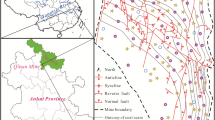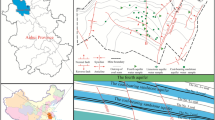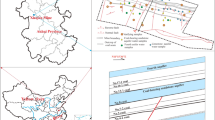Abstract
Models for recognizing the source of underground mine water is the basis for real-time monitoring of the water source in active underground mines. Real-time monitoring of the water source is of great significance for predicting water inrush and controlling flooding disasters. This study used the hydrochemistry data of the main aquifers of the Ningtiaota Coal Mine, Jiaozuo Coal Mine, Xieyi Coal Mine, and Huacheng Coal Mine. Through contrast experiments, the influence of dimension reduction processing of discriminant indexes and the selection of discriminant analysis methods in the recognition of the ability of the mine water source model were analyzed for different sample sizes for hydrochemistry data. The research shows that when the sample size is small, the dimension reduction processing using stepwise discriminant analysis and principal component analysis can significantly improve the model’s ability to recognize the mine water source. The recognition accuracy of the model using the distance discriminant method is significantly lower than that of the other two methods, and the recognition ability of the Bayes model is slightly better than that of the Fisher model. When the sample size is large enough, the dimension reduction processing can no longer improve the recognition ability of the model, and all three methods have the same recognition ability. This study can provide an important reference for the establishment and optimization of mine water source recognition, and it is expected to be significant for the prediction and prevention of coal mine water inrush events.






Similar content being viewed by others
References
Anees M, Shah MM, Qureshi AA (2015) Isotope studies and chemical investigations of Tattapani hot springs in Kotli (Kashmir, NE Pakistan): implications on reservoir origin and temperature. Procedia Earth Planet Sci 13:291–295
Bottrell S, Tellam J, Bartlett R, Hughes A (2008) Isotopic composition of sulfate as a tracer of natural and anthropogenic influences on groundwater geochemistry in an urban sandstone aquifer, Birmingham, UK. Appl Geochem 23(8):2382–2394
Brooks JP, Lee EK (2010) Analysis of the consistency of a mixed integer programming-based multi-category constrained discriminant model. Ann Oper Res 174(1):147–168
Chen HJ, Li XB, Liu AH (2009a) Studies of water source determination method of mine water inrush based on Bayes’ multi-group stepwise discriminant analysis theory. Rock Soil Mech 30(12):3655–3659
Chen HJ, Li XB, Liu AH, Peng SQ (2009b) Identifying of mine water inrush sources by Fisher discriminant analysis method. J Cent South U 40(4):1114–1120
Chen W, Hong H, Li S, Shahabi H, Wang Y, Wang X, Ahmad BB (2019a) Flood susceptibility modelling using novel hybrid approach of reduced-error pruning trees with bagging and random subspace ensembles. J Hydrol 575:864–873
Chen W, Panahi M, Khosravi K, Pourghasemi HR, Rezaie F, Parvinnezhad D (2019b) Spatial prediction of groundwater potentiality using ANFIS ensembled with teaching-learning-based and biogeography-based optimization. J Hydrol 572:435–448
Chen, W., Pradhan, B., Li, S., Shahabi, H., Rizeei, H.M., Hou, E., Wang, S., 2019c. Novel hybrid integration approach of bagging-based Fisher’s linear discriminant function for groundwater potential analysis. Nat Resour Res, 1-20
Chen W, Tsangaratos P, Ilia I, Duan Z, Chen X (2019d) Groundwater spring potential mapping using population-based evolutionary algorithms and data mining methods. Sci Total Environ 684:31–49
Chen W, Shahabi H, Zhang S, Khosravi K, Shirzadi A, Chapi K, Pham BT, Zhang T, Zhang L, Chai H, Ma J, Chen Y, Wang X, Li R, Ahmad BB (2018) Landslide susceptibility modeling based on GIS and novel bagging-based kernel logistic regression. Appl Sci 8(12):2540
Gong FQ, Lu JT (2014) Recognition method of mine water inrush sources based on the principal element analysis and distance discrimination analysis. J Min Saf Eng 31(2):236–242
Hu WY, Tian G (2010) Mine water disaster type and prevention and control countermeasures in China. Coal Sci Technol 38(1):92–96
Huang PH, Chen JS (2011a) Fisher identify and mixing model based on multivariate statistical analysis of mine water inrush sources. J China Coal Soc 36(Sup 1):131–136
Huang PH, Chen JS (2011b) The chemical features of ground water and FDA model used to distinguish source of water burst in Jiaozuo mine area. Coal Geol Explor 39(2):42–46
Liu F (2007) Hydrogeochemistry survey technology of mine groundwater hazard source. Coal Geol Explor 35(4):62–64
Lu JT, Li XB, Gong FQ, Wang XR, Liu J (2012) Recognizing of mine water inrush sources based on principal components analysis and fisher discrimination analysis method. China Saf Sci J 22(7):109–115
Petelet-Giraud E, Negrel P, Gourcy L, Schmidt C, Schirmer M (2007) Geochemical and isotopic constraints on groundwater–surface water interactions in a highly anthropized site. The Wolfen/Bitterfeld megasite (Mulde subcatchment, Germany). Environ Pollut 148(3):707–717
Pham AM, Nakai S (1984) Application of stepwise discriminant analysis to high pressure liquid chromatography profiles of water extract for judging ripening of Cheddar cheese. J Dairy Sci 67(7):1390–1396
Pirc S, Uhan J (1991) Application of hydrochemistry for prediction water irruptions in Zasavje collieries. Proc 4th Int Mine Water Assoc Congr 1:279-289
Qian JZ, Tong Y, Ma L, Zhao WD, Zhang RG, He XR (2018) Hydrochemical characteristics and groundwater source identification of a multiple aquifer system in a coal mine. Mine Water Environ 37(3):528–540
Sanliyuksel D, Baba A (2011) Hydrogeochemical and isotopic composition of a low-temperature geothermal source in Northwest Turkey: case study of Kirkgecit geothermal area. Environ Earth Sci 62(3):529–540
Shi L, Xu LY (2010) Prediction of mine water inrush sources based on cluster analysis of hydrogeochemical features. Coal Sci Technol 38(3):97–100
Sophian A, Tian GY, Taylor D, Rudlin J (2003) A feature extraction technique based on principal component analysis for pulsed eddy current NDT. NDT E Int 36(1):37–41
Sun LH (2014) Statistical analysis of hydrochemistry of groundwater and its implications for water source identification: a case study. Arab J Geosci 7(9):3417–3425
Sun LH, Gui HR (2012) Establishment of water source discrimination model in coal mine by using hydrogeochemistry and statistical analysis: a case study from Renlou coal mine in northern Anhui Province, China. J Coal Sci Eng 18(4):385–389
Teng JW, Zhang XM, Yang H (2008) Exploration and exploitation in second deep space of crust interior and high efficient utilization of the major energy——coal resource in China. Prog Geophys 23(4):972–992
Vapnik VN (1999) An overview of statistical learning theory. IEEE Trans Neural Netw 10(5):988–999
Wang GC, Wang XH, Li JS (1998) Identification model of gushing water sources in Pingdingshan coal mines. Coal Geol Explor 26(6):47–50
Wang J, Li XB et al (2011a) Application of distance discriminant analysis method to headstream recognition of water-bursting source. Procedia Eng 26:374–381
Wang XY, Ji HY, Wang Q, Liu XM, Huang D, Yao XP, Chen GS (2016) Divisions based on groundwater chemical characteristics and discrimination of water inrush sources in the Pingdingshan coalfield. Environ Earth Sci 75(10):872
Wang XY, Xu T, Huang D (2011b) Application of distance discriminance in identifying water inrush resource in similar coalmine. J China Coal Soc 36(8):1354–1358
Wu Q, Cui FP, Zhao SQ, Liu SJ, Zeng YF, Gu YW (2013) Type classification and main characteristics of mine water disasters. J China Coal Soc 38(4):561–565
Wu Q, Mu WP, Xing Y, Qian C, Shen JJ, Wang Y, Zhao DK (2017) Source discrimination of mine water inrush using multiple methods: a case study from the Beiyangzhuang mine. Northern China Bulletin Eng Geology Environ:1–14
Zhang XL, Zhang ZX, Peng SP (2003) Application of the second theory of quantification in identifying gushing water sources of coal mines. J China U Min Technol 32(3):251–254
Zhou J, Shi XZ, Wang HY (2010) Water-bursting source determination of mine based on distance discriminant analysis model. J China Coal Soc 35(2):278–282
Funding
This research was financially supported by general project of national natural science foundation of China (Grant No. 41472234).
Author information
Authors and Affiliations
Corresponding author
Additional information
Responsible Editor: Fernando Al Pacheco
Rights and permissions
About this article
Cite this article
Hou, E., Wen, Q., Che, X. et al. Study on recognition of mine water sources based on statistical analysis. Arab J Geosci 13, 5 (2020). https://doi.org/10.1007/s12517-019-4984-x
Received:
Accepted:
Published:
DOI: https://doi.org/10.1007/s12517-019-4984-x




